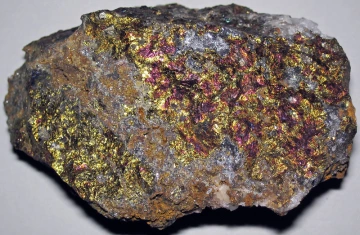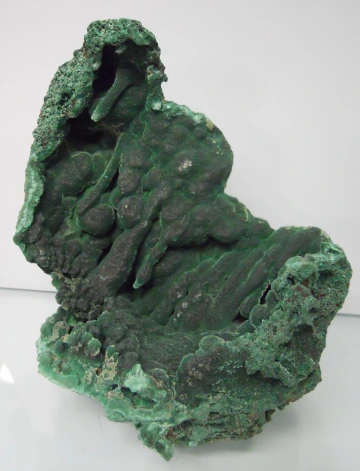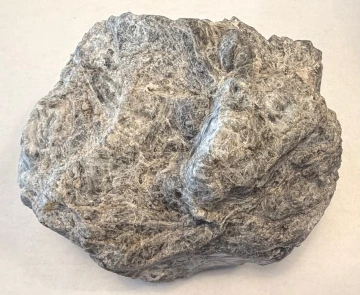Below is more information about the four Arizona ores and industrial minerals from the AMMNRE Museum's sandbox mining activity at the 2025 Mines for Limitless Minds event.
For more information about the museum, click here.
For our blog and news articles, click here.
Got questions? Find our contact information here.

Chalcopyrite from Pinal County, Arizona.
James St. John https://www.flickr.com/photos/jsjgeology/
Chalcopyrite (CuFeS2)
Chalcopyrite is the main copper-bearing mineral in porphyry copper deposits as well as hydrothermal veins and contact metamorphic zones. It is one of the most important copper-bearing minerals, with a copper content of about 34.5%, and is commonly a brassy or iridescent color with a metallic luster. It often forms in association with other sulfide minerals and can be found alongside other metal ores including iron, gold, silver, zinc, lead, molybdenum, and others. Chalcopyrite is mined through both open-pit and underground methods at most of Arizona’s large copper mines as the primary ore of copper.
COPPER: The native element copper has a myriad of uses due to its various properties. It is conductive to heat and electricity, malleable and ductile, antimicrobial, and infinitely recyclable. In industry, copper is widely used for electrical wiring and circuit boards due to its conductivity, durability, and resistance to corrosion. It is one of the most important minerals needed for renewable energy technologies like solar panels, wind turbines, and electric vehicle components. Copper is also an essential mineral for human health. It helps make energy, form red blood cells, create collagen and connective tissues, and it supports the nervous and immune systems. It is also used in the healthcare industry due to its antimicrobial properties.
Arizona is the leading copper-producing state in the country, producing about two thirds of the nation’s copper, and much of that comes from mining and processing the mineral chalcopyrite.

Malachite from the Copper Queen Mine, Bisbee, Arizona.
AMMNRE Museum collection specimen.
Malachite (Cu₂CO₃(OH)₂)
Malachite is a green copper carbonate hydroxide mineral. It typically forms in the oxidized (weathering) zones of copper deposits, when slightly acidic water containing dissolved carbon dioxide seeps through the rock and dissolves primary copper minerals, often copper sulfides. The resulting copper‑rich solution travels until it encounters carbonate ions from dissolved carbon dioxide, groundwater, or carbonate rocks. There, the copper combines with carbonate and hydroxide to form malachite.
Malachite is known for its vibrant green color and diverse forms. It can occur as crystalline aggregates or crusts, botryoidal (rounded) clusters, fibrous or needle-like (acicular) crystals, radiating structures, or stalactitic masses. Its unique forms, patterns, and banding are directly influenced by the environmental conditions during its formation as well as changes in the surrounding chemical composition.
Malachite is considered a copper ore but is often lower in copper content than sulfide ores like chalcopyrite. It is often found alongside other copper minerals such as azurite (blue), chrysocolla (blue-green), cuprite (red to black), or native copper. Historic specimens from Arizona's famous mining localities such as the Copper Queen Mine in Bisbee are especially popular with collectors. Our museum collection, which dates back to a display at the Arizona Territorial Fair in 1884, contains many of these classic specimens.

Perlite from Picketpost Mountain area, Superior, Arizona.
AMMNRE Museum photo.
Perlite (Volcanic Rock)
Perlite is an amorphous volcanic glass that forms from the rapid cooling of high-silica lava. It is characterized by its relatively high water content, typically trapped within the structure during the lava's cooling process. When perlite is rapidly heated, the water inside vaporizes and causes the material to expand up to 20 times its original volume. This process creates a lightweight, porous structure that gives perlite its unique physical properties.
Because of its low density, thermal insulation, and inert chemical nature, expanded perlite is widely used across several industries and considered an important industrial mineral. In construction, it serves as a lightweight aggregate in plaster, concrete, and insulation materials. In agriculture and horticulture, perlite is prized for its ability to improve soil aeration and drainage, making it ideal for potting mixes and hydroponic systems. It's also used in industrial filtration, cryogenic insulation, and lightweight packaging materials.
Perlite is mined in regions with significant volcanic activity, including in Superior, Arizona, near Picketpost Mountain. The perlite at that locality is hosted within flows of the middle-Tertiary age (15 to 18.6 million years ago) Arnett Rhyolite. It is found with black "apache tear" nodules of obsidian. Apache tears hold spiritual and cultural meaning for Native American tribes in Arizona, particularly the Apache tribe.

Scoria is used for traction on snow in Flagstaff, Arizona.
AMMNRE Museum photo.
Scoria (Volcanic Cinders)
Scorias, also known as volcanic cinders, are small, porous fragments of volcanic rock formed during explosive eruptions of basaltic to andesitic magma. They are created when molten lava is ejected into the air and cools rapidly, trapping gas bubbles inside, which gives them a vesicular, lightweight texture. The rock contains mostly silica (SiO2), as well as iron oxides (FeO and Fe₂O₃), magnesium oxide (MgO), calcium oxide (CaO), and aluminum oxide (Al₂O₃). They can be black, red, or brown in color.
The cinders around Flagstaff, Arizona, which are mined as industrial minerals, primarily come from basaltic eruptions associated with the San Francisco volcanic field, which contains over 600 cinder cones spread across roughly 1,800 square miles in northern Arizona. The most recent eruption of the San Francisco Volcanic Field was at Sunset Crater around the year 1085 CE.
Volcanic cinders have a range of industrial uses due to their low density, high porosity, and thermal resistance. In construction, they serve as lightweight aggregate in concrete, road base, and roofing materials. They are also popular in landscaping for soil improvement and decorative ground cover. Other uses include filtration systems, thermal insulation, abrasives, and drainage solutions in environmental and septic systems.

